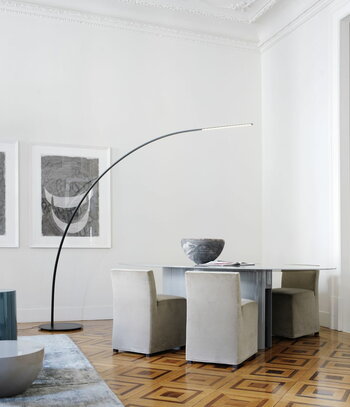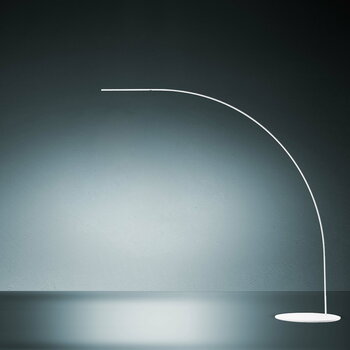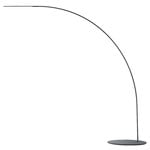FontanaArte’s Yumi floor lamp was designed by Shigeru Ban in 2011. Yumi is Japanese for bow, and the slim, arched structure of Yumi floor lamp does indeed resemble a curved bow. With its height of over two metres, Yumi combines a bold appearance with understated elegance. The carbon fibre structure makes it both strong and lightweight, and the 170 dimmable LEDs fill the space with either bright downward light or softly glowing ambience. A winner of iF Design Award 2014, Yumi is an excellent choice for both private and public environments.
Yumi floor lamp
FontanaArte
Description
FontanaArte’s Yumi floor lamp was designed by Shigeru Ban in 2011. Yumi is Japanese for bow, and the slim, arched structure of Yumi floor lamp does indeed resemble a curved bow. With its height of over two metres, Yumi combines a bold appearance with understated elegance. The carbon fibre structure makes it both strong and lightweight, and the 170 dimmable LEDs fill the space with either bright downward light or softly glowing ambience. A winner of iF Design Award 2014, Yumi is an excellent choice for both private and public environments.
Product details (16)
- Material
- Black: Carbon fiber structure, metal base. White: Aluminium structure, metal base
- Colour
- Black or white
- Length
- 250 cm
- Width
- 50 cm
- Base diameter
- 50 cm
- Height
- 210 cm
- Light source
- 240 x integrated dimmable 22W LED
- Colour temperature
- 2,700 K
- Luminous flux
- 2,400 lm
- IP rating
- 20
- Protection class
- II
- Voltage
- 220–240 V
- Certifications and labels
- CE, EAC
- Plug
- EU, UK, US, AUS
- Dimmable
- Yes
- Notes
- This luminaire contains built-in LED lamps that cannot be changed.
- Product ID
Designer
Shigeru Ban (b. 1957) is an internationally recognized Japanese architect who works also as industrial designer. He studied at the Southern California Institute of Architecture and later on in the Cooper Union School of Architecture, graduating in 1984. Shigeru Ban can be described as a modernist, experimentalist as well as a rationalist.
The architect is most famous for his innovative work with paper tubes as a material for building construction. Ban’s architecture has strong influences from his interest in humanitarianism. He is concerned with building as a whole, and is not interested only in so-called beautiful architecture. He has been a pioneer in applying the principles of sustainable development to architectural design. Ban’s architecture emphasises refinement and a highly developed innovativeness, especially in materials technologies. His original and bold approach to the use of paper, cardboard and bamboo as construction materials, combined with a clean-lined and contemporary architectural aesthetic, has made him one of the most important architects of our time. Shigeru Ban’s most important works include among many other things the Japanese Pavilion at the Hannover Expo 2000 and the new Centre Georges Pompidou in Metz. In 2007, Shigeru Ban designed the Artek Pavilion, “The Space of Silence”, for the 2007 International Milan Furniture and Design Fair. For the Artek Pavilion he used a new material made of recycled plastic and paper by UPM Finland. 10-Unit System, also designed for Artek, was developed with the same material. 10-Unit system is a modular furniture system, consisting of several L-units, which allows to create different pieces of furniture – chairs, tables, benches – simply combining the units. Shigeru Ban’s works have received many awards worldwide.
View all productsReviews (0)
Sustainability
This product does not yet have a sustainability rating.
Learn more.










